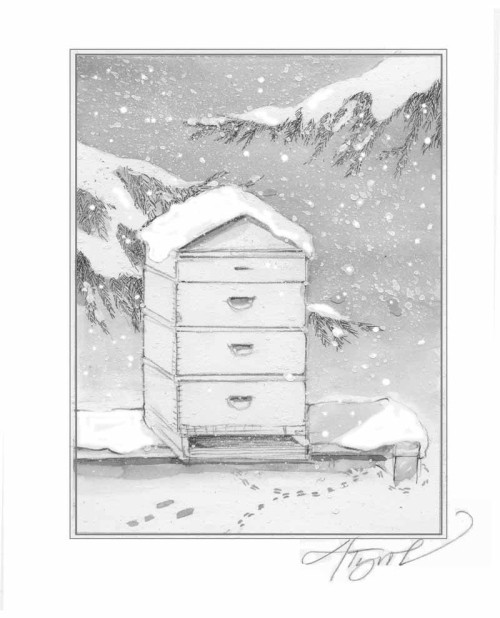
Insects have evolved a variety of different strategies for surviving the sub-zero temperatures of winter. Many spend the winter in a simple life stage – usually an egg – which is easier to protect from frost damage than a multi-cellular adult or larvae. Honeybees employ a rather unique strategy analogous to turning on the furnace or stoking the wood stove: by huddling together and shivering their flight muscles, honeybees generate heat, keeping the hive warm. With thousands of bees in a colony and an ample supply of stored food (honey), they can afford to huddle and shiver all winter long.
Other insects avoid winter’s chill by migrating. Some, such as the monarch butterfly and many dragonflies, migrate hundreds or even thousands of miles. Others migrate underground, moving deep enough to get below the frostline. Still others spend the winter in an aquatic life stage ensconced beneath the ice of ponds and streams. But two of the most fascinating overwintering strategies are known as freeze tolerance (essentially freezing solid while anti-freeze compounds prevent cell damage) and freeze avoidance, which involves lowering the freezing point of an insect’s body fluids below 32 degrees F – a process also known as supercooling.
Normal water freezes at 32 degrees F, but pure, distilled water can be supercooled to much lower temperatures before ice forms. In fact, microscopic droplets of pure water can be cooled to as low as 40 degrees F below zero before freezing. Normal water freezes at 32 degrees F because the growth of ice crystals is “seeded” by the presence of some particle or impurity that helps to line up the water molecules into the crystal shape. This phenomenon is similar to what occurs in making fudge, when the syrup has more than cooled enough to crystallize but cannot start doing so until it is disturbed or a sugar crystal is dropped in.
In general, insects are good at this trick of supercooling due to their small body size (the smaller the better when it comes to supercooling). In addition, the waxy cuticle that coats their bodies provides excellent waterproofing and prevents external ice from coming into contact with body fluids. Even in summer, most insects can tolerate temperatures down at least 23 degrees F. In winter, however, insects can push supercooling even lower by producing two different compounds – antifreeze proteins and cryoprotectants.
Antifreeze proteins bind to microscopic ice crystals as they start to form in the insect’s body fluids, preventing the crystals from growing any larger. For insects that spend the winter near the surface of the ground covered by a blanket of insulating snow, the production of antifreeze proteins allows them to supercool to about -5 degrees F. Insects that spend the winter high up in trees or in other exposed sites can push the envelope much farther, producing cryoprotectants in addition to proteins and achieving supercooling as low as -40 degrees F.
The most common cryoprotectant is glycerol, an alcohol that is quite similar to ethylene glycol, the chemical that we use as antifreeze in our cars. Cryoprotectants work because the freezing point of water decreases as the proportion of dissolved substances in the water increases. So the more cryoprotectant that can be packed into an insect’s body fluids, the lower the temperature at which it will freeze. In some insect species, the concentration of glycerol can make up as much as 20 to 25 percent of their total body mass.
As with any overwintering strategy, there are dangers to relying on supercooling. Sudden, abnormal blasts of arctic cold can drop the temperature below an insect’s freeze threshold with dire consequences, since an insect cannot quickly pump in more cryoprotectant when the temperature dips to deadly levels. Similarly, for insects that rely on the insulating properties of the snowpack, low-snow winters can expose them to killing temperatures. And, like the cooling fudge, if a supercooled insect comes in contact with ice crystals, its body fluids will be seeded, resulting in flash-freezing and sudden death.
Some insects avoid this supercooling gamble altogether, having evolved an ability to freeze without being killed. As with supercooling, insects manufacture cryoprotectants that, in this case, are pumped inside individual cells, preventing the cells from freezing. Ice will form outside of cell walls but not inside them. Ice crystals can fill up an insect’s body, surrounding all the internal tissues and even growing throughout the blood vessels, but the animal survives because the insides of its cells remain liquid. This strategy is not limited to insects and other invertebrates but is also used by a few of their amphibian predators, including spring peeper, wood frog, and grey treefrog, whose emergence in a few months will herald the start of spring.

